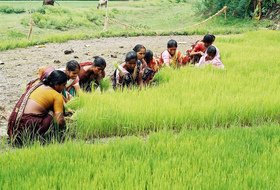|
Food Security- A Human Right
F ood security is a human right and is a fundamental ask for poverty eradication and sustainable development. As the world prepares for the post-2015 scenario by drawing up a set of Sustainable Development Goals (SDGs), it is crucial to have food security and agriculture to be adequately placed in the discussions around these goals.While the Millennium Development Goals (MDGs) addressed food security in its goal on eradicating extreme poverty and hunger, it missed to explicitly address the driving factor of agriculture. Learning from the gaps in MDGs and understanding the inter-linkages in food demand and supply chain, the second goal amongst the seventeen proposed SDGs is dedicated to "end hunger, achieve food security and improve nutrition and promote sustainable agriculture".1 Considering that a large population of the world suffers from malnutrition and sleeps on an empty stomach, the Open Working Groups through consultations, are aiming to clearly link these problems to the solutions offered by sustainable agriculture which would increase agricultural productivity while ensuring efficient use of resources. Taking further the concerns raised by MDGs on hunger
eradication throu • Increase productivity • Help maintain ecosystems • Strengthen capacity for adaptation to climate change, extreme weather, drought, floods and other disasters • Progressively improve land and soil quality Focusing on the larger policy outcome levels, the SDGs intend to make the international policies affecting food prices, trade, food safety and investment in the agricultural sector more enabling and supportive for least developed countries and their agricultural produce. Furthermore, the SDG on food security and agriculture has brought up the concern of sustainable food production, wasteful food consumption patterns and unequal access and distribution. It therefore calls for the need to improve agricultural value chains and reduce food waste at all stages – including post-harvest and storage losses as well as consumption. In order to meet the resource needs for increasing food demands, SDGs propose integration of sustainable use of resources (water, land, forests) in efforts to intensify agriculture. It further suggests incorporating a framework for corporate social and environmental responsibility and private sector engagement for agri-business linkages.2 Thus at large, the goal on food security and sustainable agriculture proposes to emphasise on some essential elements for ensuring sustainable development such as natural resource management, ecosystem protection, equity, resource efficiency, sustainable production and consumption and resilience building of indigenous and vulnerable communities. Considering that food is a basic human right, eradication of hunger should be at the centre of all decisions made for the goal on food security and sustainable agriculture. Simultaneously, the post - 2015 development agenda would have to overcome the challenges for sustainable agriculture production and promote the scaling of these solutions through support in the form of improved market infrastructure, public and private investment and cooperation for technology and knowledge transfer. Most importantly, farmers have to be made central to the efforts and adequate investment has to be made for their capacity building and for securing access to know how, inputs, services and finances. q Harshita Bisht Endnotes |
 gh
calorie intake, the SDGs through its targets, also emphasise on meeting
nutritional needs and addressing under-nutrition, micronutrient
deficiencies and obesity. To meet these nutritional needs, increasing
the agricultural productivity and incomes of small-scale food producers,
particularly women and indigenous people is particularly emphasised in
the goal. Through promotion of secure and equal access to land, other
productive resources and inputs, knowledge, financial services, markets,
opportunities for value addition and non-farm employment, the SDGs
broadly support an agenda for equity that prioritises vulnerable
populations and farming systems. The goal aims to ensure sustainable
food production systems and implement resilient agricultural practices
that:
gh
calorie intake, the SDGs through its targets, also emphasise on meeting
nutritional needs and addressing under-nutrition, micronutrient
deficiencies and obesity. To meet these nutritional needs, increasing
the agricultural productivity and incomes of small-scale food producers,
particularly women and indigenous people is particularly emphasised in
the goal. Through promotion of secure and equal access to land, other
productive resources and inputs, knowledge, financial services, markets,
opportunities for value addition and non-farm employment, the SDGs
broadly support an agenda for equity that prioritises vulnerable
populations and farming systems. The goal aims to ensure sustainable
food production systems and implement resilient agricultural practices
that: